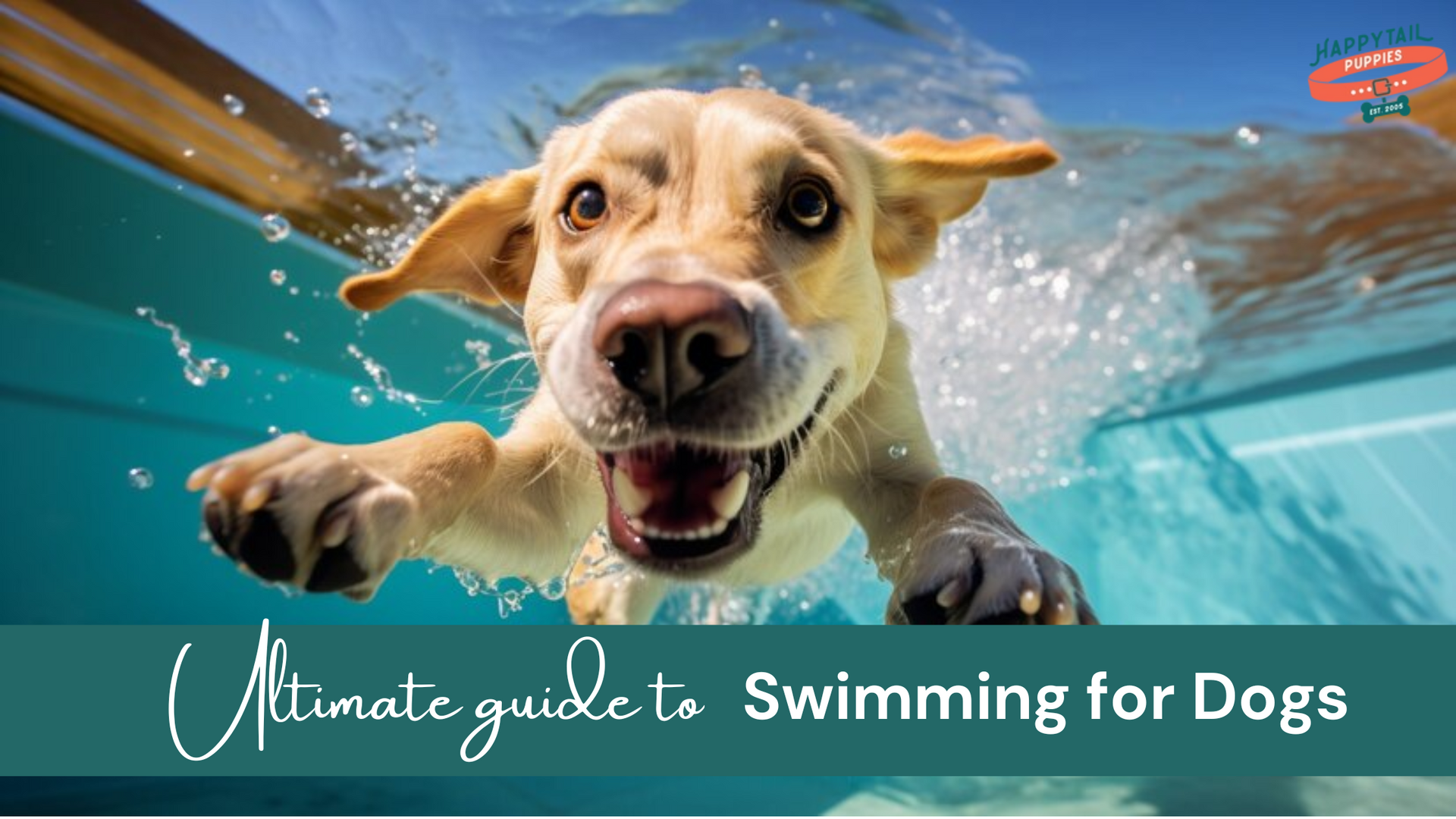The Ultimate Guide to Swimming for Dogs: Benefits, Tips, and Safety
Exercise forms the core part of a healthy dog's routine. Numerous dog owners focus on keeping their pets active with games of fetch or regular walks. However, over time, the same routine turns stale. If you ever get bored of it, try imagining how bored your dog becomes.
If you wish to add a new activity to the routine, consider swimming for dogs. Dogs love swimming, and it is the best way to get them outdoors and make them stay active. In our post today, we will discuss a few essential tips and tricks for teaching your dog to swim so that you and your pet can exercise in new and exciting ways.
What Are the Benefits of Swimming for Dogs?
So, how beneficial is swimming for dogs? Let us check them out.
Physical Health Benefits
Swimming can help build muscle mass and enhance better flexibility in dogs, leading to greater overall strength; however, it plays an essential role in weight management for our furry friends. The water buoyancy supports the weight of the dog, which enables them to engage in physical activities without imposing greater strain on the joints, making it the perfect exercise for overweight dogs seeking to shed some pounds. For instance, breeds such as Yorkshire Terriers or Labradoodles are known to love water and have higher energy levels that would benefit from swimming, maintaining a healthy weight, and staying active.
Along with weight loss, swimming is specifically beneficial for dogs with joint disorders. For example, dogs who suffer from hip dysplasia or arthritis can find relief across the low-impact way of swimming as it can help minimize inflammation in the joints, leading to enhanced mobility and reduced discomfort. The greater engagement in the swimming sessions helps the dogs with such conditions experience a notable enhancement to their life's quality that enables them to move comfortably while enjoying better motion.
Mental Health Benefits
Swimming effectively offers more than just physical benefits; it also brings notable mental benefits. For example, anxious or timid dogs would benefit significantly from swimming, as it would enhance their independence and confidence. These are exemplified by the cases where earlier hesitant dogs eventually became more comfortable and self-assured in the water. It shows greater improvements in their overall nature and behavior.
Additionally, swimming would bring about a better sense of joy and freedom in dogs that contributes positively to their mental health. The dogs would display a natural sense of contentment and happiness while swimming, displaying their natural affinity to water and the fun they have through this activity. The better sense of enjoyment and freedom brings a therapeutic impact on dogs, minimizing their stress levels, and promoting relaxation that is identical to the perks experienced by humans engaging in the recreational activities they love.
Therapeutic Benefits
Swimming has evolved as the core element in the care and rehabilitation of dogs with numerous health conditions. Hydrotherapy facilities are at the forefront of this practice, offering specialized equipment such as underwater treadmills streamlined to meet the distinctive needs of dogs. For example, dogs undergoing neurological or orthopedic injuries will benefit from aquatic therapy, which includes swimming, since it helps to enhance their recovery outcomes by boosting strength and mobility.
Furthermore, regular swimming practices will help prevent the atrophy of muscles while helping to maintain better body conditions for dogs with restricted mobility. It is the core aspect that is important to promote the overall well-being of the dogs while ensuring that they lead a fulfilling life irrespective of the health challenges. For instance, try engaging them with swim therapy for dogs, as if they experience arthritis or dysplasia, they will have enhanced joint mobility and minimized discomfort that contributes to the best life quality.

How to Get Started with Swimming for Dogs?
Although a few dogs often take to water naturally, others would need a gradual or gentle introduction; start introducing your dog to the shallow water, allowing them to get used to this feeling. Over time, you can guide them to the deeper depths of water while ensuring that they feel comfortable and safe when you are swimming with a dog. It is important to create a positive experience for your dog. Try encouraging them with praises and treats while reinforcing their confidence in the water. Remain patient, and do not force your dog to swim if they are scared.
Consider investing in a couple of swimming for dogs accessories to boost their pool experience. Dog life jackets are important for safety, and the floating toys add an extra amount of fun. Additionally, consider using dog-friendly sunscreen for breeds with short fur or light-colored coats to safeguard them against sunburn.
Safety Tips for Swimming with a Dog
Here are a couple of safety tips to swim with a dog.
Supervision and Monitoring
It is essential to stay vigilant and always be at your pup's side at all times, especially with the small dog breeds like Teacup Chihuahua or Toy Poodle. In the outdoor instances, mainly on the beach, the currents or the strong waves would seamlessly sweep your pup away. If you teach your pup to swim in a pond or a lake, then your puppy will often become tired, and if you shift your focus, then they will start sinking or drowning. Always ensure that they are wearing their life vests in these situations as a precaution.
Recognizing Signs of Fatigue
Your dogs would often get salt intoxicated after they have ingested large amounts of ocean water while swimming. You need to avoid them ingesting the pool chemicals. Whenever you are in water with your pup then you should watch over them to ensure they do not drink water. The best tip is to carry a bowl and drinking water and offer your pups regular breaks from swimming or give them the scope to drink clean water and relax for some time. If you reinforce your dog after drinking out of their water bowl, then they will quickly adapt to this idea.
Preventing Ear Infections
The bigger lakes are often a safe and fun place for dogs. Try avoiding the lakes with algae on the surface as it proves toxic, leading to ear or eye infections as well as GI upset. Keep a look out for the shore for dangerous debris while steering, clearing any water that appears dirty, stagnant, or containing trash or debris. The well-maintained swimming pool is often safer for dogs to swim in. Pool water, whether it is saltwater or chlorine then it is not considered harmful and any circumstances. The pool chemicals lead to skin irritation and dryness in both animals and humans, mainly if they swim frequently.

Indoor Swimming for Dogs
Indoor swimming for dogs offers numerous benefits. One of the notable perks is the ability to swim throughout the year, with the indoor pools offering better scope for swimming irrespective of the weather conditions. It indicates that your dog is enjoying the perks of swimming in the cold winter months or on rainy days. Furthermore, indoor facilities often feature controlled spaces with regulated temperatures, making it a comfortable experience for your dogs. These spaces will minimize the risk linked with external dangers like rough water or pollutants to ensure safer swimming sessions for your furry companion.
There are a couple of considerations while seeking indoor swimming facilities for your dog. You should perform your research about the local facilities, look for better reviews and a strong reputation towards cleanliness and safety. After you have a couple of options, visit these facilities, ensuring that they are well-staffed and well-maintained with expert professionals. It offers you the peace of mind that your pet is swimming in a controlled and safe environment.
Swim Therapy for Dogs
Swim therapy for dogs mainly comprises swimming as the best exercise that helps in the recovery and well-being of your pet. It is mainly curated for dogs who are recovering from injuries or surgeries in order to deal with their arthritis condition or mobility issues. Involves using swimming as a therapeutic exercise to help with recovery and enhance overall health. The buoyancy of water aids in managing the weight of the dog, minimizing the strain on their joints and enabling them to move freely. It is what makes swim therapy highly effective as a mode of rehabilitation.
The process of swimming can prove helpful to seniors or an injured dog, as illustrated below. It assists in increasing the degree of flexibility for a number of movements, which may lead to improved flexibility. The water resistance as a function assists in quick muscle build-up, which is more relevant for dogs that are recovering from injuries. Moreover, what is interesting, an environment of water provides considerable relaxation of pain sensations and lessens discomfort as well as improves the overall state of a dog’s body.
However, when it comes to dog care, it is crucial to look for a qualified swim therapist, and only they can guarantee ideal conditions. When looking for practitioners to provide canine hydrotherapy, search for those with the following credentials: Ensure the practitioner has the level of knowledge and training needed. Here, experience is the tool; hence, I prefer a therapist who has dealt with other dogs with similar complications. Lastly, the appearance and hygiene of the facility should be noble, and the center must have a good reputation with adequate equipment. It provides the best environment to complement the recovery process and, more so, the well-being of the dog.
Fun Swimming Activities and Games
It is important to keep your dogs active and entertained in water, especially by incorporating swimming games. Playing fetch with floating toys is the ideal way to engage with your dogs. Another fun game is water tug-of-war using durable water toys, ensuring that it lasts through the fun. Create simple water obstacle courses with floating devices while offering challenge and variety that keeps your dog physically and mentally stimulated.
Swimming together would notably strengthen the bond between you and your furry companion. You can spend quality time in the water, promoting companionship and trust, while your dog learns to depend on you for safety and support. Shared achievements and fun in the water boost your relationship while fostering positive experiences enjoyed by both.
Frequently Asked Question
Let us find out some commonly asked questions that numerous pet owners wonder.
Is swimming better than running for dogs?
It's no wonder that one minute of swimming is often equivalent to about four minutes of running for a dog. Swimming also helps in faster recovery from strain, surgery, or sprain. It also helps with age-related limitations such as stiffness, arthritis, and reduced mobility.
How long should dogs swim for?
Swimming for about 10 minutes may cause fatigue, as it is equivalent to about forty minutes of running. Consider how long your pet can swim safely. Typically, brachycephalic breeds would often swim for about ten to fifteen minutes, while senior overweight dogs would manage their 20-minute sessions.
Do dogs get tired after swimming?
It is important to frequently call out your dog from swimming and use commands to get him to rest in the shade. Ensure that he has fresh drinking water. Too much swimming can often lead to dehydration or exhaustion.
Does swimming build muscle in dogs?
Swimming for dogs often engages different types of muscles, including the back, core, and limbs. Regular swimming can help your dog to build their muscles, enhance overall health and boost their balance and agility.
Do dogs prefer warm or cold water?
It is often seen that dogs are discriminatory in their choices for drinking water, like humans, who prefer to drink cool water.
Conclusion
If your dog loves to swim, then there are numerous ways in which you can make your sessions fun-filled. If you are entering into the water you can play the game of fetch or water tag. A few dogs love to jump into deeper water to fetch a toy, known as dock diving, and if you have had pool and a foam raft for your dog to jump on. At Happytail Puppies, we also create personalized plans for you to help train your puppies in the best way. Our personalized training packages for puppies for sale can help meet their specific conditions and needs.


